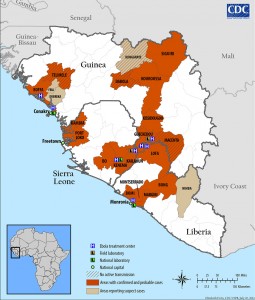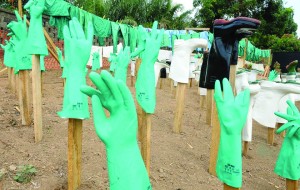On September 19, Sierra Leone began a three-day national lockdown to prevent the spread of the Ebola virus. A day earlier the UN Security Council had declared the outbreak a “threat to peace and security,” and agreed to send an emergency mission to provide treatment to and control the spread of the virus in West Africa. And on September 30, a fateful blood test confirmed the first case of Ebola diagnosed in the United States.
Since August, each day has brought new breaking headlines about the ongoing health crisis of Ebola. By many accounts, the disease’s recent rise on the international scene is long-delayed, since the outbreak started in December 2013. As of September 22, the virus had killed more than 3,000 people in Sierra Leone, Senegal, Guinea, Liberia, and Nigeria. Reported cases were approximately at 6,500, but underreporting was, and still is, highly probable. Every day, morbidity and mortality from Ebola increases. As the virus travels to densely populated urban areas, it is unlikely to slow down its unprecedented spread. The outbreak has certainly reached pandemic proportions and a serious, targeted global response is underway.
The Ebola outbreak has blossomed into a modern pandemic. From its humble beginnings in a bat reservoir to the infection of thousands throughout West Africa, the virus has proven its malignancy. However, Ebola is still a mystery to many researchers and treatment for the disease is limited. International efforts to control this elusive pandemic face an important challenge.

So, what is Ebola? And why is it so dangerous?
Ebola is a zoonotic virus that resides in bat reservoirs, usually without any obvious symptoms. There are five identified strains of Ebola all in the family Flovidiae and the genus Ebolavirus, and all five cause disease in humans and nonhuman primates. Each strain has a different level of virulence, or rate of death among the people that are infected. The virus is transferred harmlessly among the primary host population, migratory fruit bats. But when it invades the secondary host, non-human primates or humans, it starts to show pathological effects.
Previous Ebola outbreaks were linked to the bushmeat trade, when humans consumed infected non-human primates. However, the 2014 outbreak began with a single infected bat that bit a two year old toddler in the village Meliandoua in eastern Guinea. In less than a week, the infected toddler and his mother had died. The virus spread to mourners at their funeral.
The symptoms of Ebola in humans include fever, vomiting, nausea, headache, sore throat, and internal as well as external hemorrhaging. Although these symptoms may not be immediately visible, their onset is quick and debilitating. It begins with fever and headaches. Gastrointestinal problems are quick to follow, and result in vomiting, nausea, and diarrhea. The virus’ access to the vascular system leads to bleeding under the skin, bleeding within internal organs, and bleeding from the eyes, ears, and mouth. In early stages, symptoms are difficult to distinguish from those of other parasitic diseases or viral infections, such as malaria, typhoid fever, or meningitis, which are all common in West Africa. This makes the identification of Ebola cases more challenging, and leads to misdiagnosis or underreporting. The mystique surrounding the disease continues to grow, bolstering its enigmatic image.
The incubation period for the virus ranges from a few days to several weeks, and the virus remains alive and contagious even after the death of the individual. This increases transmission of the virus during funeral rituals for the deceased. The disease is spread through bodily fluids, including blood. Unlike some infectious diseases, the Ebola virus is not transmitted through aerosols, although some expert virologists fear that mutations in the virus could lead to aerosol transmission. Aerosol transmission is particularly frightening because it increases ease of transmission and affects more individuals.
In the animal reservoir, the virus has a conserved DNA sequence that is surprisingly stable. According to Dr. James Childs, the 1995 virus was nearly identical to the virus isolated in 1976. Childs is a zoonotic disease specialist at the Yale School of Public Health, and he worked for the Center for Disease Control (CDC) from 1992 until 2003. His experience includes a four-week stint in Zaire (now the Democratic Republic of the Congo, or the DRC) during the 1995 Ebola outbreak.
Within the human population, increasing transmission rates of Ebola also increase the probability of genetic mutation in the viral sequence as it is passed from one individual to the next. It is unlikely that these mutations would lead to aerosol transmission, although scientists speculate that these mutations may alter the virus, further hindering diagnosis.

Once a case of Ebola is identified, basic treatment such as providing fluids, stabilizing electrolytes, and maintaining blood pressure are performed on the patient to increase the chance of survival. Another major issue is that infected patients are often highly susceptible to other infections. Fighting these other diseases is a part of Ebola treatment. Vaccines are currently under research and development to be used in the battle against Ebola. However, none of these vaccines are advanced enough to be commercially available. For example, ZMapp is being developed by Mapp Biopharmaceutical Inc., but it is in the experimental stage and has yet to be confirmed for safety and efficacy in humans.
Childs emphasized the importance of contact-trace history and quarantine in controlling the spread of the disease. Previous outbreaks were isolated to smaller rural communities, but the 2014 outbreak has already reached major cities. The President of Sierra Leon’s request for more hospital beds is important since overflowing hospitals means that infected individuals must return to their local communities, where they will exacerbate spread of the disease.
As the number of cases grows, tracing the history of the disease from each individual becomes increasingly complicated. A serious dearth of trained medical personnel compounds the lack of facilities and financial resources in West Africa. According to Childs, the logistics of tracking individuals, quarantining, and providing adequate care are challenging in areas that lack infrastructure. Cultural issues also affect response to the disease: funeral rites for the deceased, stigma of reporting, and mistrust of the healthcare system all contribute to the problem. While the global response to the Ebola outbreak has crawled along at a maddening pace, the serious nature of the pandemic is now being more broadly recognized. Hopefully, this will spark swift action.
Since the discovery of the Ebola virus in 1976 in the DRC, there have been 25 outbreaks in West Africa. The most deadly of these was a 1976 outbreak in Zaire, which claimed 280 lives. The current 2014 outbreak, however, has been more deadly than all of the previous outbreaks combined, which warrants more attention and more action. The potent nature of the Ebola virus is only compounded by its continued, enigmatic nature in terms of symptoms, diagnosis, and treatment. A true modern pandemic, the Ebola virus poses a serious threat to global health and requires international cooperation in solving this deadly mystery.
